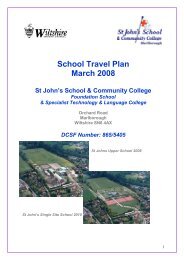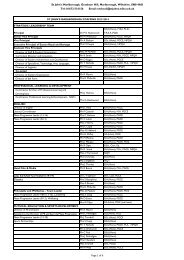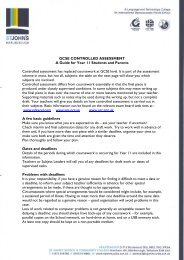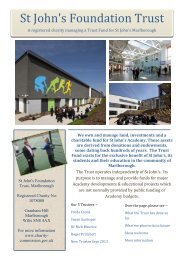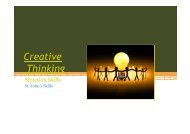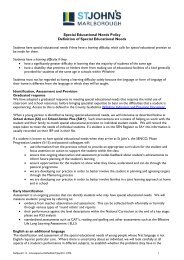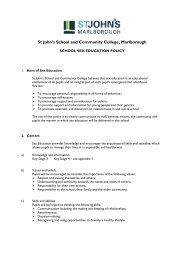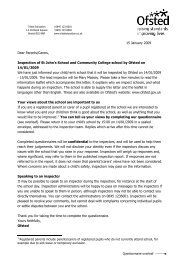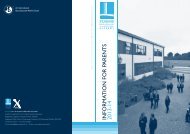How to achieve a C in English Word doc - St John's School and ...
How to achieve a C in English Word doc - St John's School and ...
How to achieve a C in English Word doc - St John's School and ...
Create successful ePaper yourself
Turn your PDF publications into a flip-book with our unique Google optimized e-Paper software.
<strong>English</strong>, <strong>English</strong> Language <strong>and</strong> Literature<br />
- Active <strong>and</strong> Diploma pathway students: <strong>English</strong> GCSE<br />
- Core-pathway students: <strong>English</strong> Language GCSE <strong>and</strong> <strong>English</strong> Literature GCSE<br />
The students at <strong>St</strong> John’s follow the AQA <strong>English</strong>, <strong>English</strong> Language <strong>and</strong> <strong>English</strong> Literature courses. Full details of the<br />
specification <strong>and</strong> criteria can be found at www.aqa.org.uk.<br />
What do the students have <strong>to</strong> do for their <strong>English</strong> GCSEs?<br />
Controlled Assessment<br />
All the GCSE courses are assessed through f<strong>in</strong>al exam<strong>in</strong>ations <strong>and</strong> ‘Controlled Assessment’. ‘Controlled Assessment’<br />
is what we knew as ‘coursework’. <strong>St</strong>udents cannot work on this at home or improve controlled assessment that they<br />
have already completed. Most controlled assessments have now been completed.<br />
<strong>English</strong><br />
Controlled Assessment – 60% of the <strong>to</strong>tal GCSE marks<br />
Speak<strong>in</strong>g <strong>and</strong> Listen<strong>in</strong>g (20%): 3 tasks assessed <strong>in</strong> lessons by class teacher.<br />
Underst<strong>and</strong><strong>in</strong>g Creative Texts (20%): 2 written tasks (poetry <strong>and</strong> ‘Of Mice <strong>and</strong> Men’).<br />
Produc<strong>in</strong>g Creative Texts (20%): 2 creative writ<strong>in</strong>g tasks (au<strong>to</strong>biographical writ<strong>in</strong>g <strong>and</strong> recreations task).<br />
<strong>English</strong> Language<br />
Controlled Assessment – 60% of the <strong>to</strong>tal GCSE marks<br />
Speak<strong>in</strong>g <strong>and</strong> Listen<strong>in</strong>g (20%): 3 tasks assessed <strong>in</strong> lessons by class teacher.<br />
Extended Read<strong>in</strong>g (15%): Written essay response on a literature text (‘Of Mice <strong>and</strong> Men’ or ‘To Kill a<br />
Mock<strong>in</strong>gbird’).<br />
Creative Writ<strong>in</strong>g (15%): 2 written tasks (Recreations <strong>and</strong> Mov<strong>in</strong>g Images)<br />
Spoken Language <strong>St</strong>udy (10%): Written <strong>in</strong>vestigation <strong>in</strong><strong>to</strong> how <strong>in</strong>ternet language compares <strong>to</strong> spoken<br />
language.<br />
<strong>English</strong> Literature<br />
Controlled Assessment – 25% of the <strong>to</strong>tal GCSE marks<br />
The Significance of Shakespeare <strong>and</strong> the <strong>English</strong> Literary Heritage (25%): Written essay response that<br />
compares William Shakespeare’s ‘Romeo <strong>and</strong> Juliet’ <strong>and</strong> Jane Austen’s ‘Pride <strong>and</strong> Prejudice’.<br />
Rema<strong>in</strong><strong>in</strong>g Controlled Assessment<br />
- <strong>English</strong> Literature: The Significance of Shakespeare <strong>and</strong> the <strong>English</strong> Literary Heritage.<br />
- All students Speak<strong>in</strong>g <strong>and</strong> Listen<strong>in</strong>g: Discuss<strong>in</strong>g<br />
Specific texts <strong>and</strong> questions<br />
Information regard<strong>in</strong>g precise details of texts studied can be obta<strong>in</strong>ed from the <strong>in</strong>dividual class teachers.<br />
Incomplete Controlled Assessment<br />
Throughout the academic year the <strong>English</strong> department has been arrang<strong>in</strong>g lunch time catch up sessions <strong>and</strong> if<br />
necessary, days off timetable for students <strong>to</strong> complete all their controlled assessment pieces.<br />
Mark<strong>in</strong>g Controlled Assessment<br />
All controlled assessment marks are moderated by the <strong>English</strong> department, <strong>to</strong> ensure fair <strong>and</strong> accurate mark<strong>in</strong>g. The<br />
f<strong>in</strong>al marks are submitted <strong>to</strong> the exam board prior <strong>to</strong> the exam<strong>in</strong>ations themselves <strong>and</strong> are then reviewed <strong>and</strong><br />
moderated by AQA’s exam<strong>in</strong>ers <strong>and</strong> modera<strong>to</strong>rs.
The Exams<br />
Any students on the Diploma or Active pathway will be sitt<strong>in</strong>g one exam <strong>in</strong> the summer. Core-pathway students will<br />
be sitt<strong>in</strong>g three f<strong>in</strong>al exams.<br />
<strong>English</strong> <strong>and</strong> <strong>English</strong> Language<br />
Unit 1: Underst<strong>and</strong><strong>in</strong>g <strong>and</strong> Produc<strong>in</strong>g Creative Texts (4 th June 2013) is 2 hours <strong>and</strong> consists of 2 sections.<br />
It is worth 40% of the <strong>to</strong>tal GCSE Marks.<br />
Section A: Read<strong>in</strong>g (20%)<br />
This consists of a variety of questions on a number of unseen non-fiction texts (newspaper articles, advertisements<br />
<strong>and</strong>/or <strong>in</strong>ternet <strong>doc</strong>uments)<br />
At higher tier – 4 questions on 3 texts<br />
At foundation tier – 5 shorter questions on 3 shorter texts.<br />
<strong>St</strong>udents are asked <strong>to</strong> identify key arguments; expla<strong>in</strong> why various facts <strong>and</strong> op<strong>in</strong>ions are used; comment on the<br />
context of the piece (i.e. author <strong>and</strong> target audience) <strong>and</strong> analyse language features (such as formal/<strong>in</strong>formal<br />
language, persuasive devices, <strong>and</strong> emotive language). They also need <strong>to</strong> underst<strong>and</strong> <strong>and</strong> analyse presentational<br />
devices (layout, font, sub-head<strong>in</strong>gs, text organisation, <strong>and</strong> images/symbolism).<br />
Section B: Writ<strong>in</strong>g (20%)<br />
This section consists of two compulsory tasks:<br />
1) Writ<strong>in</strong>g <strong>to</strong> <strong>in</strong>form, expla<strong>in</strong> or describe (16 marks)<br />
2) Writ<strong>in</strong>g <strong>to</strong> argue or persuade (24 marks)<br />
This is where students are assessed on their writ<strong>in</strong>g ability <strong>in</strong>clud<strong>in</strong>g spell<strong>in</strong>g, punctuation <strong>and</strong> grammar. Ability <strong>to</strong><br />
write <strong>to</strong> suit purpose <strong>and</strong> audience is also important, as well as paragraph<strong>in</strong>g <strong>and</strong> use of vocabulary.<br />
<strong>English</strong> Literature<br />
Unit 1: Explor<strong>in</strong>g Modern Texts (20 th May 2013) is 1hr 30 m<strong>in</strong>s <strong>and</strong> consists of 2 sections.<br />
Section A: Modern Prose or Drama – Essay response from a choice of two questions.<br />
Section B: Explor<strong>in</strong>g Cultures – C<strong>and</strong>idates answer one question, <strong>in</strong> two parts, on the set text. (a: response <strong>to</strong><br />
a passage from the text / b: c<strong>and</strong>idates l<strong>in</strong>k the passage <strong>to</strong> a whole text).<br />
Unit 2: Poetry Across Time (23 rd May 2013) is 1hr 15 m<strong>in</strong>s <strong>and</strong> consists of 2 sections.<br />
Section A: Poetry Cluster from the Anthology (45 m<strong>in</strong>s 36 marks) – Essay response on the ‘Relationships’<br />
cluster. C<strong>and</strong>idates compare one named poem with another chosen by the c<strong>and</strong>idate.<br />
Section B: Respond<strong>in</strong>g <strong>to</strong> an unseen poem (30 m<strong>in</strong>s 18 marks) – A compulsory unseen poem. C<strong>and</strong>idates<br />
answer a compulsory question about the poem. (F tier – question is <strong>in</strong> two parts).<br />
Revision tips<br />
Tips on what students need <strong>to</strong> focus on for the exams <strong>and</strong> how they can revise are <strong>to</strong> follow. <strong>How</strong>ever, some useful<br />
revision websites <strong>in</strong>clude:<br />
http://www.bbc.co.uk/schools/gcsebitesize/<br />
http://www.englishbiz.co.uk/<br />
http://www.s-cool.co.uk/gcse
<strong>English</strong> Exam – Tips <strong>and</strong> Guidance<br />
<strong>English</strong>/<strong>English</strong> Language (All <strong>St</strong>udents)<br />
Unit 1: Underst<strong>and</strong><strong>in</strong>g <strong>and</strong> Produc<strong>in</strong>g Creative Texts (4 th June 2013) is 2 hours <strong>and</strong> consists<br />
of 2 sections.<br />
Section A: Read<strong>in</strong>g non-fiction <strong>and</strong> media texts (20%)<br />
<strong>St</strong>udents are given 2/ 3 texts <strong>to</strong> read <strong>and</strong> answer questions. This could be a newspaper article, advert, webpage etc.<br />
- Skills be<strong>in</strong>g assessed: us<strong>in</strong>g quotes as evidence, comparisons, underst<strong>and</strong><strong>in</strong>g fact <strong>and</strong> op<strong>in</strong>ion, presentational<br />
devices, l<strong>in</strong>guistic devices.<br />
- Ways <strong>to</strong> revise:<br />
• Read a range of newspapers at home: identify GAP, highlight the techniques, facts, op<strong>in</strong>ions, layout <strong>and</strong><br />
presentation used etc. (Use AQA tips for students sheet)<br />
• Look at the number of marks <strong>and</strong> plan out response which takes approximately 2 m<strong>in</strong>utes per mark.<br />
• Use mnemonics <strong>to</strong> remember techniques: AFOREST (alliteration, fact, op<strong>in</strong>ion, rhe<strong>to</strong>rical question, emotive<br />
language, statistic, triplet/rule of three etc.)<br />
• This is the part of the exam paper that students most often f<strong>in</strong>d difficult. This is often because they struggle<br />
with the language of the exam question, or do not properly focus on only writ<strong>in</strong>g what is be<strong>in</strong>g asked for<br />
(mistakenly believ<strong>in</strong>g that the exam<strong>in</strong>er wants their op<strong>in</strong>ion on the extracts.)<br />
• Practise writ<strong>in</strong>g paragraphs on authors’ use of language; presentational devices; fact <strong>and</strong> op<strong>in</strong>ion...<br />
- Tips for students:<br />
• Read the questions carefully <strong>and</strong> ignore any irrelevant <strong>in</strong>formation.<br />
• Look at the number of marks designated <strong>to</strong> the question <strong>and</strong> divide your time accord<strong>in</strong>gly.<br />
• Use the exam texts: highlight, annotate, underl<strong>in</strong>e, circle...<br />
• Use the language of the exam question<br />
• Read the texts more than once – the second time with the questions <strong>in</strong> m<strong>in</strong>d.<br />
Section B: Writ<strong>in</strong>g (20%)<br />
<strong>St</strong>udents need <strong>to</strong> answer two compulsory questions; this means they need <strong>to</strong> be prepared <strong>to</strong> write different styles of<br />
text.<br />
1) Writ<strong>in</strong>g <strong>to</strong> <strong>in</strong>form, expla<strong>in</strong> or describe (16 marks)<br />
- <strong>St</strong>udents are be<strong>in</strong>g assessed on effective use of paragraphs; use of <strong>in</strong>terest<strong>in</strong>g <strong>and</strong> appropriate vocabulary;<br />
match<strong>in</strong>g style <strong>and</strong> <strong>to</strong>ne <strong>to</strong> the reader (specified <strong>in</strong> the question); accuracy of spell<strong>in</strong>g <strong>and</strong> punctuation.<br />
- Ways <strong>to</strong> revise:<br />
• Write a description of a variety of people, places <strong>and</strong> th<strong>in</strong>gs us<strong>in</strong>g all 5 senses<br />
• Use a thesaurus <strong>to</strong> develop vocabulary<br />
• Use SAMSOAP mnemonic for descriptive writ<strong>in</strong>g (senses, alliteration, metaphors, similes, onoma<strong>to</strong>poeia,<br />
assonance <strong>and</strong> personification)<br />
• Practise spell<strong>in</strong>gs: look, cover, write, check<br />
• Practise writ<strong>in</strong>g for different forms: newspaper articles, letters, speeches (use real texts as models)<br />
• Look at past answers from lessons <strong>and</strong> redraft/improve them<br />
2) Writ<strong>in</strong>g <strong>to</strong> argue or persuade (24 marks)<br />
- <strong>St</strong>udents need <strong>to</strong> be clear of the differences between persuade <strong>and</strong> argue. This part of the paper is worth the most<br />
marks.<br />
- <strong>St</strong>udents are be<strong>in</strong>g assessed on effective use of paragraphs; use of <strong>in</strong>terest<strong>in</strong>g <strong>and</strong> appropriate vocabulary;<br />
match<strong>in</strong>g style <strong>and</strong> <strong>to</strong>ne <strong>to</strong> the reader (specified <strong>in</strong> the question); accuracy of spell<strong>in</strong>g <strong>and</strong> punctuation.<br />
- Ways <strong>to</strong> revise:<br />
• Memorise a list of connective words <strong>and</strong> phrases<br />
• Practise spell<strong>in</strong>gs: look, cover, write, check<br />
• Use AFOREST techniques <strong>in</strong> exam answers – when revis<strong>in</strong>g, ask someone for an issue or op<strong>in</strong>ion then <strong>in</strong>vent<br />
an argument which <strong>in</strong>cludes these techniques.
• Look at past answers from lessons <strong>and</strong> redraft <strong>and</strong> improve them.<br />
- Key tips for students:<br />
• Always plan your response (by paragraphs <strong>to</strong> ensure you use them)<br />
• Spend less time on the first writ<strong>in</strong>g task than the second<br />
• Always proof read your work: check for spell<strong>in</strong>g, capital letters <strong>and</strong> punctuation.<br />
• Who is your target audience? Make sure your writ<strong>in</strong>g suits them.<br />
• Avoid slang <strong>and</strong> ‘ord<strong>in</strong>ary’ vocabulary.<br />
• Practise writ<strong>in</strong>g timed responses so that you can write under pressure.<br />
<strong>English</strong> Literature<br />
Unit 1: Explor<strong>in</strong>g Modern Texts (20 th May 2013) is 1hr 30 m<strong>in</strong>s <strong>and</strong> consists of 2 sections.<br />
Section A: Modern Prose or Drama (Lord of the Flies or An Inspec<strong>to</strong>r Calls)<br />
- What students are assessed on:<br />
• Analysis of language, structure <strong>and</strong> form<br />
• Ability <strong>to</strong> support answer uses textual evidence<br />
• Underst<strong>and</strong><strong>in</strong>g of key themes <strong>and</strong> characters<br />
Section B: Explor<strong>in</strong>g Cultures – C<strong>and</strong>idates answer one question, <strong>in</strong> two parts, on the set text. (a: response <strong>to</strong><br />
a passage from the text / b: c<strong>and</strong>idates l<strong>in</strong>k the passage <strong>to</strong> a whole text).<br />
- What students are assessed on:<br />
• Analysis of language, structure <strong>and</strong> form<br />
• Ability <strong>to</strong> support answer uses textual evidence<br />
• Underst<strong>and</strong><strong>in</strong>g of key themes <strong>and</strong> characters<br />
• Awareness of social <strong>and</strong> his<strong>to</strong>rical context<br />
- Ways <strong>to</strong> revise<br />
• Creat<strong>in</strong>g m<strong>in</strong>i plans <strong>to</strong> practise essay questions<br />
• Analysis of key quotations <strong>and</strong> key extracts (language)<br />
• Create timel<strong>in</strong>e of key events (structure)<br />
• M<strong>in</strong>d-map on how form <strong>in</strong>fluences mean<strong>in</strong>g e.g. play, audience, novel, reader... (form)<br />
• M<strong>in</strong>d-maps/notes on key themes <strong>and</strong> characters<br />
• Practise us<strong>in</strong>g P.E.E/P.E.A paragraphs<br />
Unit 2: Poetry Across Time (23rd May 2013) is 1hr 15 m<strong>in</strong>s <strong>and</strong> consists of 2 sections.<br />
Section A: Poetry Cluster from the Anthology (45 m<strong>in</strong>s 36 marks)<br />
-What students are assessed on:<br />
• Analysis of language, structure <strong>and</strong> form.<br />
• Ability <strong>to</strong> compare <strong>and</strong> contrast poems on a theme/<strong>to</strong>pic<br />
• Awareness of author’s techniques<br />
Section B: Respond<strong>in</strong>g <strong>to</strong> an unseen poem (30 m<strong>in</strong>s 18 marks)<br />
- What students are assessed on:<br />
• Awareness of poem’s underly<strong>in</strong>g mean<strong>in</strong>gs<br />
• Awareness of poet’s techniques <strong>and</strong> their effects<br />
• Analysis of language, structure <strong>and</strong> form.<br />
Ways <strong>to</strong> revise<br />
• Creat<strong>in</strong>g m<strong>in</strong>i plans <strong>to</strong> practise essay questions: Use STIFF/TSLAP <strong>to</strong> structure essay.<br />
• Create a grid compar<strong>in</strong>g ‘relationships’ poetry<br />
• Practise analys<strong>in</strong>g unseen poetry us<strong>in</strong>g P.E.E/P.E.A paragraphs<br />
• Revise key term<strong>in</strong>ology



